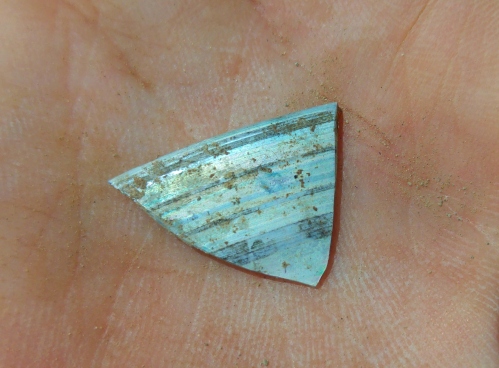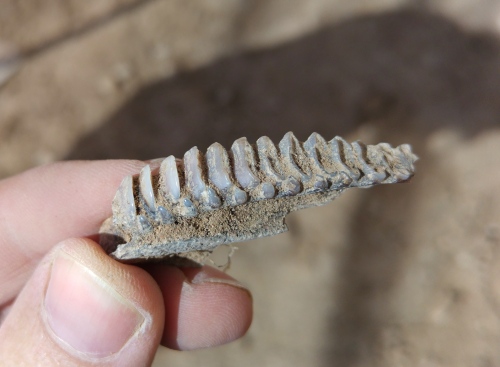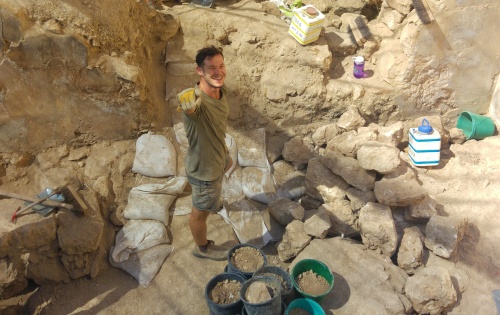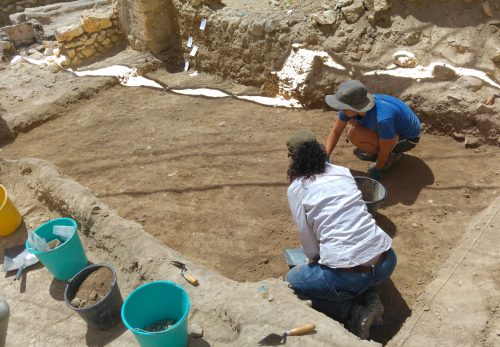Way back in the end of June, at the start of the busy summer months, I had the pleasure of taking part in yet another exciting archaeological dig. Being that I have just begun my MA degree this autumn semester, I’ve been involving myself in the Crusader period more and more. This led me to meeting up with Dr Rafi Lewis, co-director of the Mount Zion Archaeological Dig, at his excavation site just outside the Old City of Jerusalem.
Referencing from the expedition’s website, the ongoing mission of the excavation is to expose and preserve the many layers of civilisation found on Mount Zion, going back thousands of years. As with nearly everywhere in and around the Old City of Jerusalem, the veritable footprint of humanity is profound in both magnitude and multitude. Just glancing about the dig site at Mount Zion, one can see a plethora of different architectural elements seemingly stacked upon one another in a dizzyingly fashion.
Dr Rafi Lewis of Haifa University joined Drs Shimon Gibson and James Tabor, both of the University of North Carolina at Charlotte, who had been excavating at Mount Zion since 2007. Whereas Drs Gibson and Tabor have their primary foci on the Roman era and the parallel rise of Christianity, Dr Lewis focuses on the Medieval period, and even more interestingly, Crusader battlefield archaeology.
I had scheduled a day to join the dig in advance and made my way to the Old City of Jerusalem that early Wednesday morning. Arriving at the site shortly after 7am, I found a fenced off area just below Zion Gate – outside the impressive Ottoman wall of the Old City. Entering, I found Dr Lewis and made introductions before we set out on a little tour of the site. I found the range of excavated sites to be quite fascinating, and very unlike older sites such as Tel es-Safi where I excavated only Bronze and Iron age layers. Here there was so many different levels, belonging to such a varied group of historical peoples, that the very concept garnered interest.
It’s certainly hard to recall which pit belonged to which era, and which wall was built by which reigning group, but the overall picture was that there was plenty to go around for everyone will all their preferred historical periods. Dr Lewis led me over to a rectangle of brushed earth, bordered by earthen ledges and stone architectural features. He then explained that this was the floor of a Ayyubid structure, believed to have been a tower, and that we were now going to explore what lies below – presumably Fatimid ruins.
While there were dozens of people milling about the general Mount Zion dig area, there were only a handful in and around this Arab structure. We made introductions and settled down to start working, armed with the usual archaeological hand tools. Our first task was to take up the next couple inches of soil, looking out for the usual archaeological artefacts. Every so often someone would come over with a metal detector to check for coins, jewelry and other metal objects.
I was amazed at the amount of nice pottery, far nicer than the generally rough sherds I have found in the Bronze and Iron age sites I’ve traditionally excavated at. Likewise, glass was more plentiful and came in all sorts of degenerated colourations. What surprised me most, however, was a weirdly shaped hard organic item that eluded even my wildest guesses. When I asked the experts, I was informed that it was none other than the tooth of a parrotfish – imagine that!
Every now and again a coin would be found – never by me, unfortunately. However, I did find a nice piece of a mould-made oil lamp with an ornate pattern that looks like bent palm trees forming arches, encircling the pouring hole. Shortly thereafter, once the excitement had died down, another two pieces were found – one being a match, and one from a different lamp.
Another fun aspect was the high number of tesserae (mosaic stones) that were interspersed quite like cookie dough chunks in my favourite ice cream flavour. Handfuls of cubed stones were gathered up and chucked into the tesserae bucket, to be bagged, registered and dealt with at a later date.
At 9:30am we paused for breakfast, and gathered around the serving tables at the higher end of the dig site. I feasted on plums and halva, somewhat limited in what I’d eat due to the expedition’s unkosher status. It was then that I observed a familiar face working beside an excavated pit below me. This face’s owner, Ido Zangen, is comparable to the charming character Waldo in that he appears at every archaeological excavation – you simply have to search for him to find him!
After breakfast we got back to work, and we had a new manager in our Ayyubid/Fatimid tower floor: Dr Rona Avissar Lewis, the wife of Rafi Lewis. Rona had previously been a staff member at the Tel es-Safi excavation, years before my stint there. Delving back into our work, we cleared away a nice sized layer of soil, uncovering the usual ceramics, tesserae, small finds and more.
As the hour got later the sun’s rays began to punish us through the mesh shade net above us, and I sought shelter to rest. The work day was almost over, so when I was done resting and rehydrating I rejoined my digmates to do the finishing touches. I don’t know how much dirt we moved that day, but it was very exciting working on a medieval tower and I look forward to doing more.
Before I left I bid farewell to my digmates Gray, Mel and an older couple from Chicago; staff member John (a spitting image of Captain Flint in “Black Sails”); and the dig co-directors Rafi and Shimon. Feeling a wee bit peckish, I got a nice schnitzel baguette at the Central Bus Station and continued on with the rest of my day.











